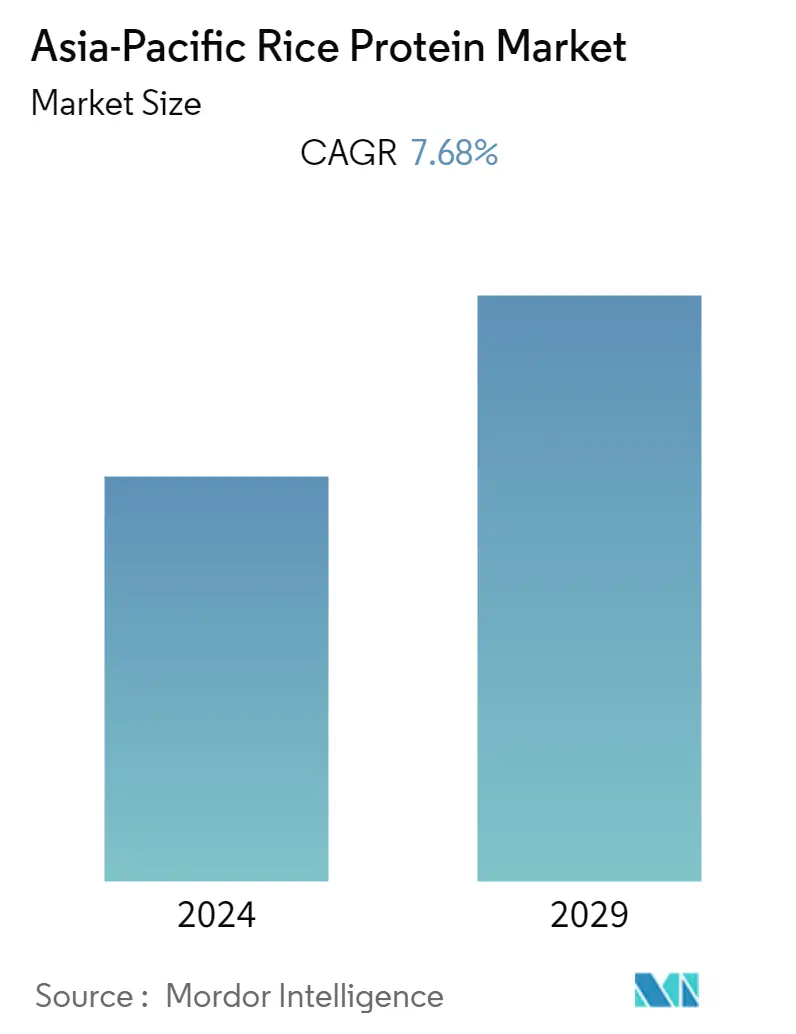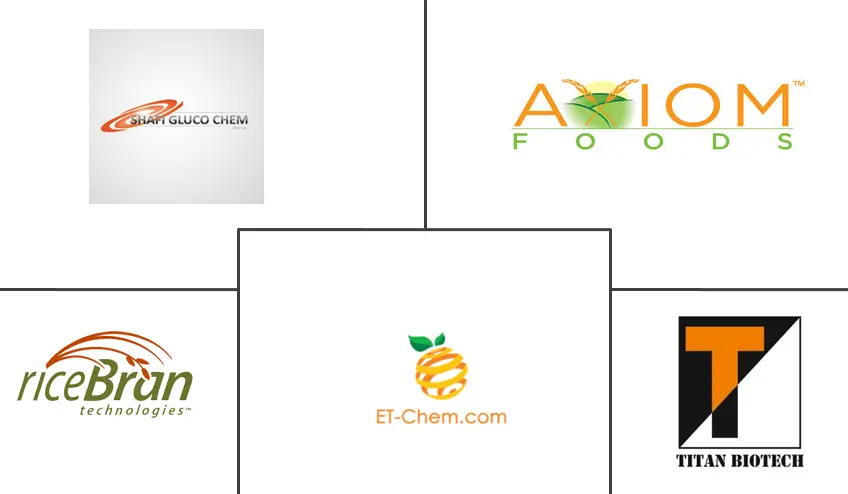Market Size of Asia-Pacific Rice Protein Industry

| Study Period | 2019 - 2029 |
| Base Year For Estimation | 2023 |
| Forecast Data Period | 2024 - 2029 |
| Historical Data Period | 2019 - 2022 |
| CAGR | 7.68 % |
| Market Concentration | Low |
Major Players
*Disclaimer: Major Players sorted in no particular order |
APAC Rice Protein Market Analysis
The Asia-Pacific rice protein market is expected to register a CAGR of 7.68%, during the forecast period, 2020-2025. Most of the major companies operating in this segment are approaching processed food manufacturers in order to encourage them to blend rice protein in a variety of products.
Countries, such as South Korea, Japan, and Hong Kong are expected to show a decline in rice consumption, owing to dietary changes, thereby, focusing more on the derivatives side, which can be utilized across processed food products as an ingredient.
The rice protein isolate segment is expected to account for the highest share during the forecast period.
APAC Rice Protein Industry Segmentation
The Asia-Pacific rice protein market is segmented by product as rice protein isolates, rice protein concentrates, and other products, by application as food ingredients: energy and sports drink, meat analogues, beverages, bakery and confectionary; dietary supplements, and animal feed. By geography, the market is available on the basis of countries as China, India, Japan, Australia, and the Rest of Asia-Pacific.
| By Product | |
| Rice Protein Isolates | |
| Rice Protein Concentrates | |
| Other Products |
| By Application | ||||||
| ||||||
| Dietary Supplements | ||||||
| Animal Feed |
| Geography | |||||||
|
Asia-Pacific Rice Protein Market Size Summary
The Asia-Pacific rice protein market is poised for significant growth, driven by increasing demand for alternative protein sources and the rising popularity of health supplements. Major companies in this sector are targeting processed food manufacturers to incorporate rice protein into various products, capitalizing on its appeal as a substitute for soy, pea, and milk proteins. Despite a decline in rice consumption in countries like South Korea, Japan, and Hong Kong due to dietary shifts, the focus is shifting towards rice protein derivatives for use in processed foods. The rice protein isolate segment is anticipated to dominate the market, supported by its high cystine and sulfur-containing amino acid content, although it is often blended with pea protein to address lysine deficiency. The growing awareness of preventive healthcare and the increasing disposable incomes in countries such as China, India, and Japan are further propelling the demand for nutrition products, encouraging manufacturers to expand their product offerings with alternative proteins.
The market is also benefiting from the rising trend of allergen- and gluten-free, easy-to-digest, and environmentally friendly products, which are driving the demand for rice protein-based dietary supplements. Rice protein's rich nutrient profile, including amino acids, vitamin E, and ferulic acid, makes it a valuable additive in foods, beverages, and cosmetics. Its mild nature makes it suitable for allergy-prone individuals, enhancing its appeal in the personal care sector. The surge in demand for cruelty-free and plant-based personal care products, fueled by increased consumer awareness through beauty blogs and social media, is contributing to market growth. Key players in the industry, such as RiceBran Technologies and Axiom Foods, are investing in research and development to innovate and improve rice protein production, aiming to meet the complexities of the market and expand their application range.
Asia-Pacific Rice Protein Market Size - Table of Contents
-
1. MARKET DYNAMICS
-
1.1 Market Drivers
-
1.2 Market Restraints
-
1.3 Porter's Five Forces Analysis
-
1.3.1 Threat of New Entrants
-
1.3.2 Bargaining Power of Buyers/Consumers
-
1.3.3 Bargaining Power of Suppliers
-
1.3.4 Threat of Substitute Products
-
1.3.5 Intensity of Competitive Rivalry
-
-
-
2. MARKET SEGMENTATION
-
2.1 By Product
-
2.1.1 Rice Protein Isolates
-
2.1.2 Rice Protein Concentrates
-
2.1.3 Other Products
-
-
2.2 By Application
-
2.2.1 Food Ingredients
-
2.2.1.1 Energy and Sports Drinks
-
2.2.1.2 Meat Analogues
-
2.2.1.3 Beverages
-
2.2.1.4 Bakery and Confectionary
-
-
2.2.2 Dietary Supplements
-
2.2.3 Animal Feed
-
-
2.3 Geography
-
2.3.1 Asia-Pacific
-
2.3.1.1 China
-
2.3.1.2 India
-
2.3.1.3 Japan
-
2.3.1.4 Australia
-
2.3.1.5 Rest of Asia-Pacific
-
-
-
Asia-Pacific Rice Protein Market Size FAQs
What is the current Asia-Pacific Rice Protein Market size?
The Asia-Pacific Rice Protein Market is projected to register a CAGR of 7.68% during the forecast period (2024-2029)
Who are the key players in Asia-Pacific Rice Protein Market?
Rice Bran Technologies, Axiom Foods, Shafi Gluco Chem Pvt. and ET Chem are the major companies operating in the Asia-Pacific Rice Protein Market.

